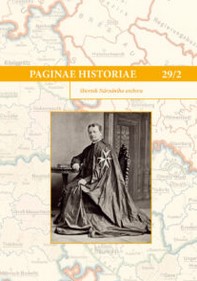STRUKTURA A IDENTIFIKACE KNĚŽSKÉ VĚTVE ČESKÉHO VELKOPŘEVORSTVÍ ŘÁDU MALTÉZSKÝCH RYTÍŘŮ V LETECH 1732–1950
STRUCTURE AND IDENTIFICATION OF THE PRIESTLY BRANCH OF THE GRAND PRIORY OF BOHEMIA OF THE ORDER OF THE KNIGHTS OF MALTA IN THE YEARS 1732–1950
Author(s): Pavel TrnkaSubject(s): Christian Theology and Religion, 18th Century, 19th Century, Pre-WW I & WW I (1900 -1919), Interwar Period (1920 - 1939), WW II and following years (1940 - 1949)
Published by: Národní archiv
Keywords: Grand Priory of Bohemia; Order of the Knights of Malta; 1732-1950;
Summary/Abstract: Members of the Order of Malta with solemn vows were divided into two branches: knightly and priestly. Order’s priests were either conventual chaplains or chaplains of obedience. At first, they differed from each other in origin, manner of reception, clothing, activities and position. Conventual chaplains went through three periods of development. The first one lasted until 1812, during which the candidates for conventual chaplains proved their noble origin. They were admitted to the Order by the provincial chapter and paid an entrance fee. Then they had to complete a six month novitiate. Their total number in the Grand Priory of Bohemia ranged from one to a maximum of three. In 1725, three small commanderies were reserved for conventual chaplains: Ebenfurth in Lower Austria, Maria Pulst in Carinthia and Haillenstein (now Polzela) in Styria. However, in order to become commanders, they had previously to spend five years in a convent in Malta. Two of these commanderies were successively sold (1748 Ebenfurth and 1779 Haillenstein). The conventual chaplains, who were also commanders, were to participate in the provincial chapter. They could also receive various ecclesiastical benefices. During the second period from 1812/1818 to the early 1920s, there was only one conventual chaplain in the Grand Priory of Bohemia, who was always the prior of the Prague convent. Since the 1920s, a prominent member of the convent could become a conventual chaplain. In addition, meritorious chaplains of obedience began to be awarded the title of conventual chaplain ad honorem. At the beginning of the 18th century, there was one chaplain of obedience in the Grand Priory of Bohemia: the titular Prague prior and parish priest at Our Lady beneath the Chain. It was not until the first half of the 1730s that the Prague convent of priests of the Order of Malta was restored. Candidates for chaplains of obedience did not have to be of noble origin. They were admitted free of charge by the prior and small chapter of the convent. After a one year novitiate, they took solemn vows and prepared for the priesthood. In 1854, simple promises were introduced. After being ordained a priest, the members of the convent most often worked in the spiritual administration. The number of parish churches administered by priests of the Order of Malta gradually increased until 1880, when there were 19. Chaplains of obedience lived either in the convent building or in individual parishes and were subordinated to the Prague prior. The convent reached its greatest size at the turn of the 19th and 20th centuries, when it consisted of more than 40 members. At the beginning of the 20th century, the convent was in a deep crisis, to which financial problems were added. This caused a decrease in the number of priests of the Order. In response to the dismal conditions in the convent, the papal visitator ordered the closure of the novitiate in 1934, and the priests began to gradually die out. In 1950, the Order of the Malta was dissolved and the last chaplains of obedience were promoted to conventual chaplains sometime between 1949 and 1969.
Journal: Paginae Historiae
- Issue Year: 29/2021
- Issue No: 2
- Page Range: 17-49
- Page Count: 33
- Language: Czech

